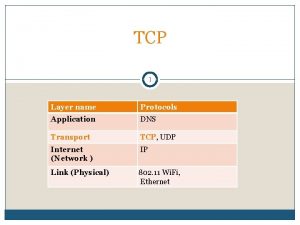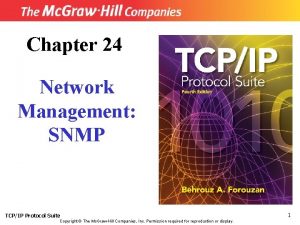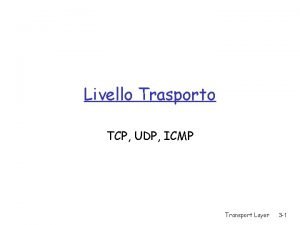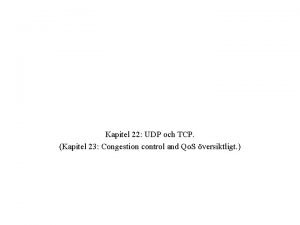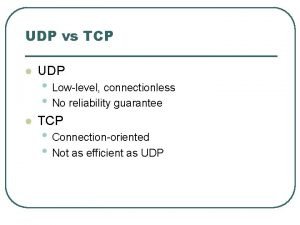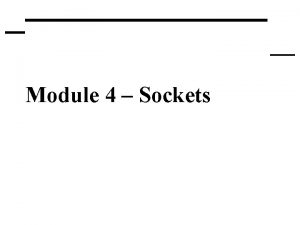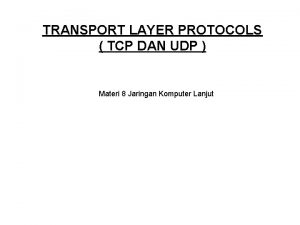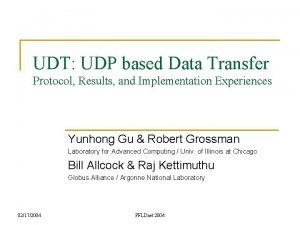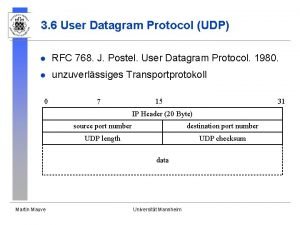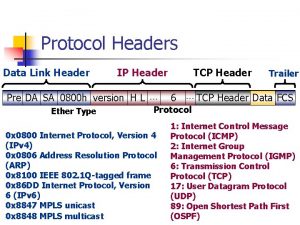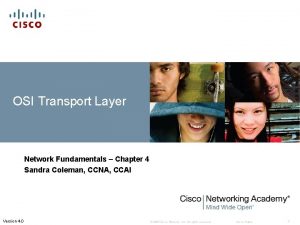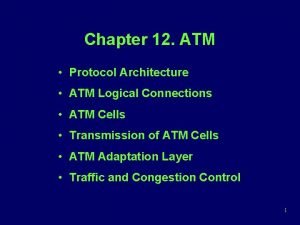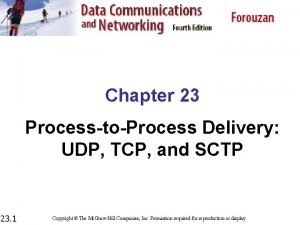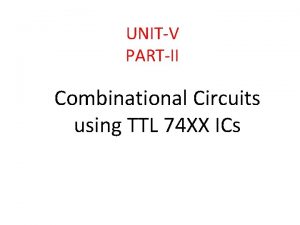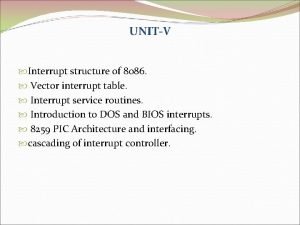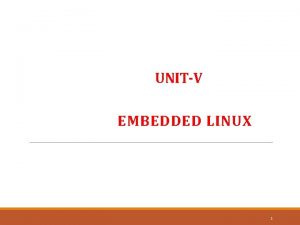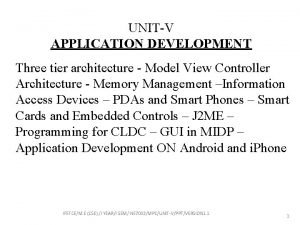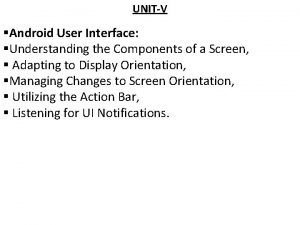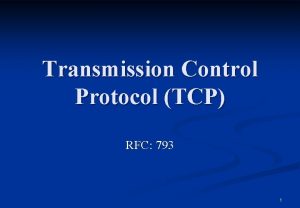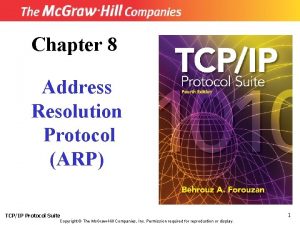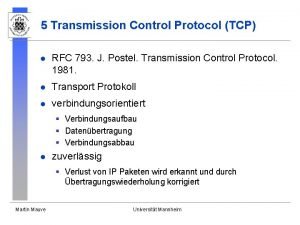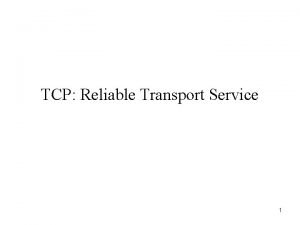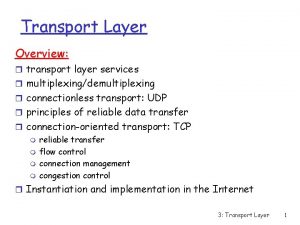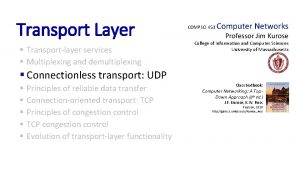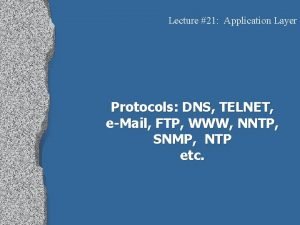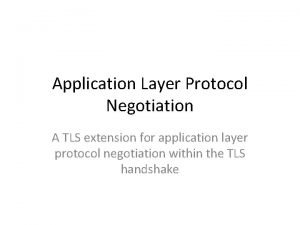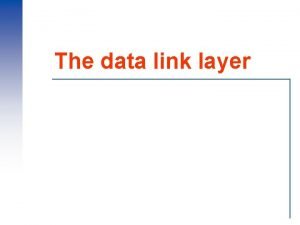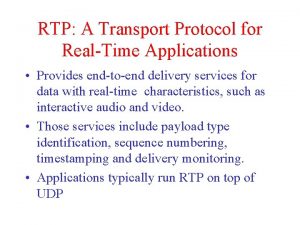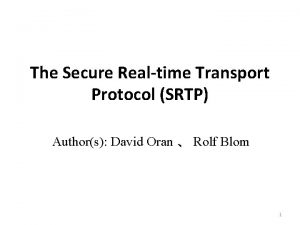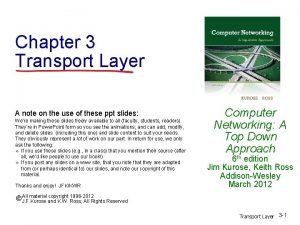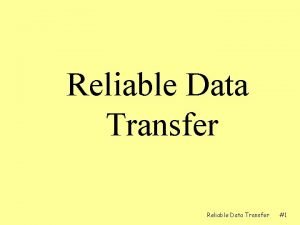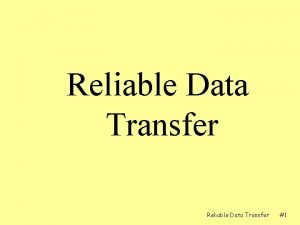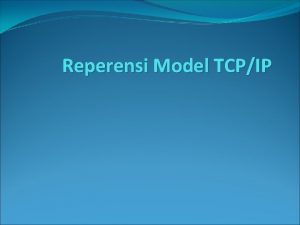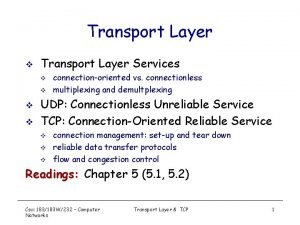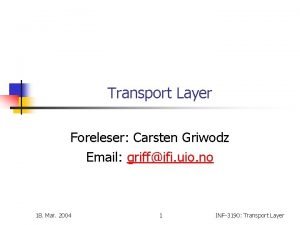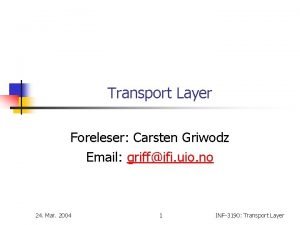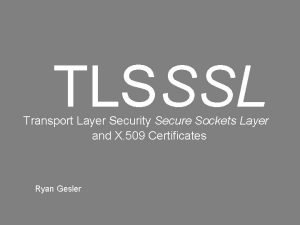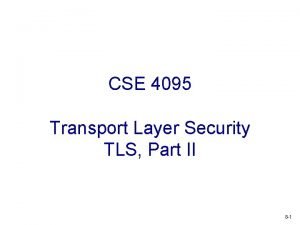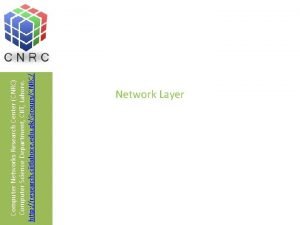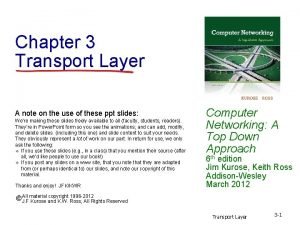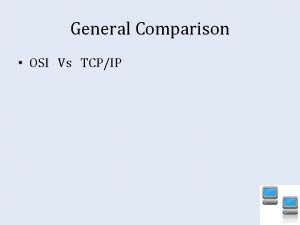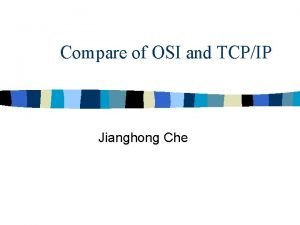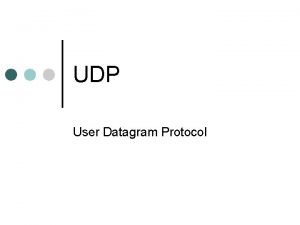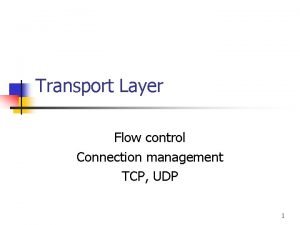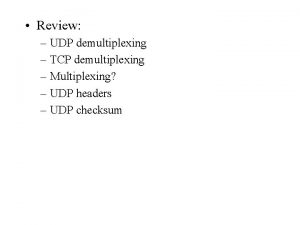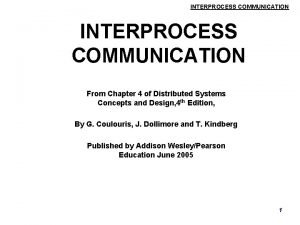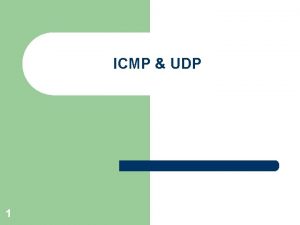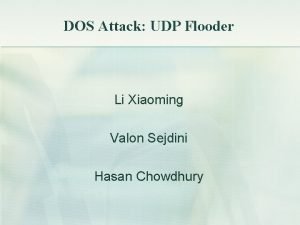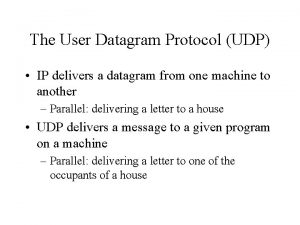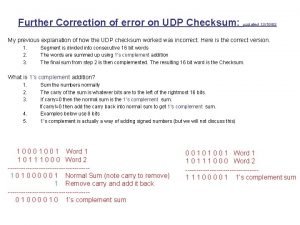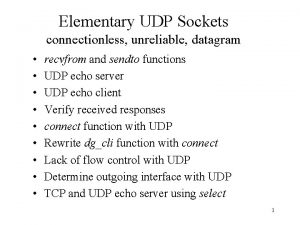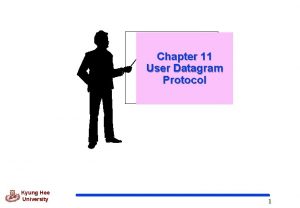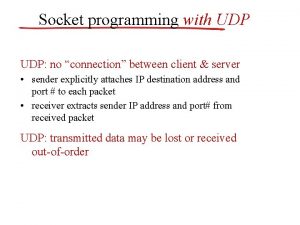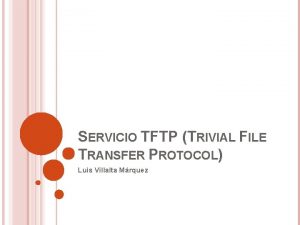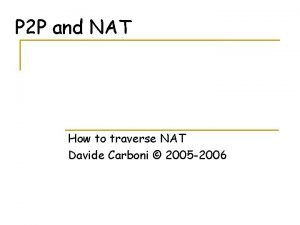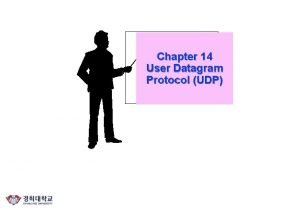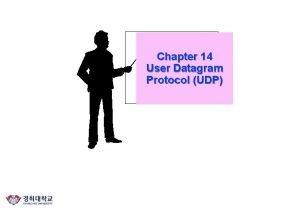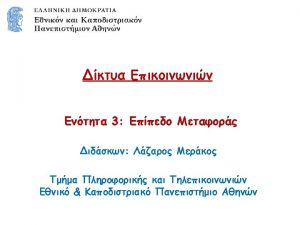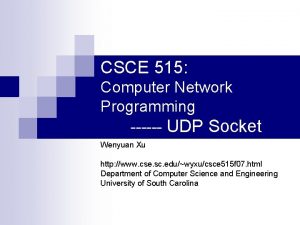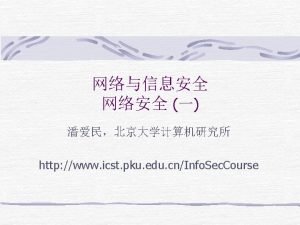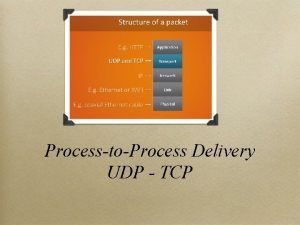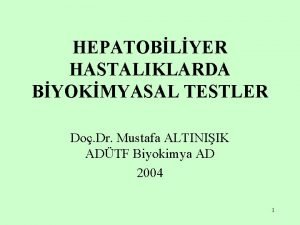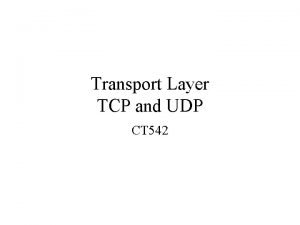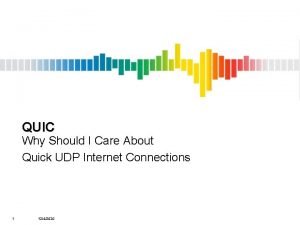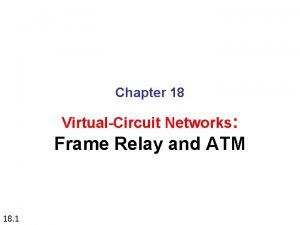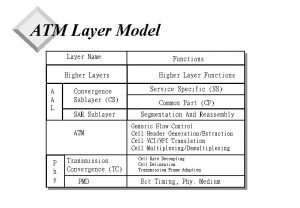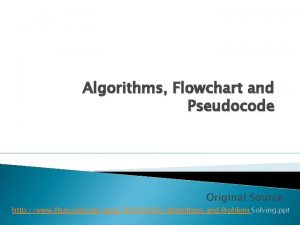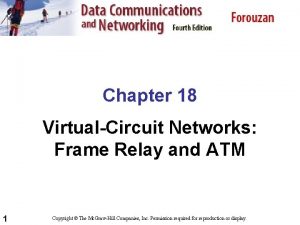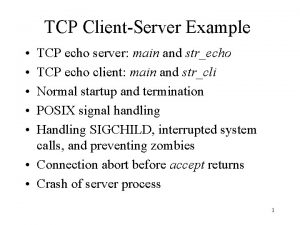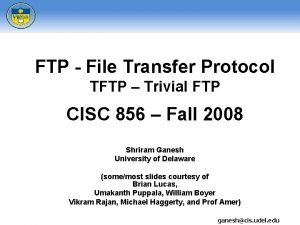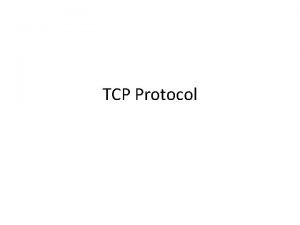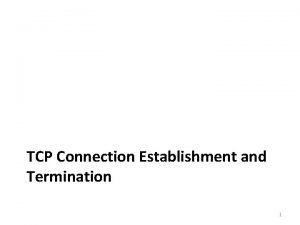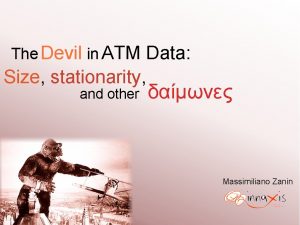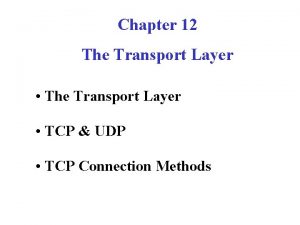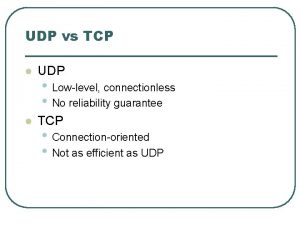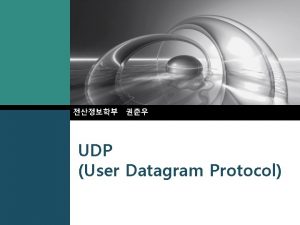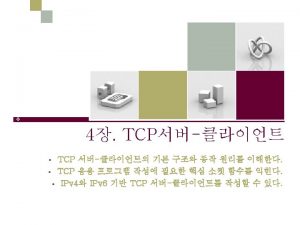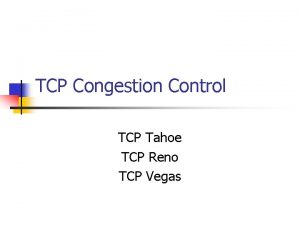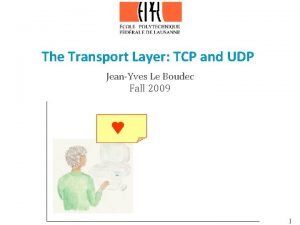UNITV Transport Layer Protocol UDP and TCP ATM



























































































































































- Slides: 155

UNIT-V Transport Layer Protocol UDP and TCP, ATM, Cryptography, Network Security

Role of Transport Layer n Application layer n n n Transport layer n n Communication for specific applications E. g. , Hyper. Text Transfer Protocol (HTTP), File Transfer Protocol (FTP), Network News Transfer Protocol (NNTP) Communication between processes Relies on network layer and serves the application layer E. g. , TCP and UDP Network layer n n n Logical communication between nodes Hides details of the link technology E. g. , IP

PROCESS-TO-PROCESS DELIVERY The transport layer is responsible for process-toprocess delivery—the delivery of a packet, part of a message, from one process to another. Two processes communicate in a client/server relationship, as we will see later. Topics discussed in this section: Client/Server Paradigm Multiplexing and Demultiplexing Connectionless Versus Connection-Oriented Service Reliable Versus Unreliable Three Protocols

n Principles underlying transport-layer services n n n (De)multiplexing Detecting corruption Reliable delivery Flow control Transport-layer protocols in the Internet n n User Datagram Protocol (UDP) Transmission Control Protocol (TCP)

Note The transport layer is responsible for process-to-process delivery.

Types of data deliveries

IP addresses versus port numbers

Multiplexing and demultiplexing

Error control

Position of UDP, TCP, and SCTP in TCP/IP suite

USER DATAGRAM PROTOCOL (UDP) The User Datagram Protocol (UDP) is called a connectionless, unreliable transport protocol. It does not add anything to the services of IP except to provide process-to-process communication instead of host-to-host communication. Topics discussed in this section: Well-Known Ports for UDP User Datagram Checksum UDP Operation Use of UDP

Table 23. 1 Well-known ports used with UDP 23. 12

User datagram format

Note UDP length = IP length – IP header’s length

Figure 23. 10 Pseudoheader for checksum calculation

Checksum calculation of a simple UDP user datagram

Queues in UDP

TCP is a connection-oriented protocol; it creates a virtual connection between two TCPs to send data. In addition, TCP uses flow and error control mechanisms at the transport level. Topics discussed in this section: TCP Services TCP Features Segment A TCP Connection Flow Control Error Control

Well-known ports used by TCP

Stream delivery

Sending and receiving buffers

TCP segments

Note The bytes of data being transferred in each connection are numbered by TCP. The numbering starts with a randomly generated number.

Example The following shows the sequence number for each segment:

Note The value in the sequence number field of a segment defines the number of the first data byte contained in that segment.

Note The value of the acknowledgment field in a segment defines the number of the next byte a party expects to receive. The acknowledgment number is cumulative.

TCP segment format

Control field

Description of flags in the control field

Connection establishment using three-way handshaking

Note A SYN segment cannot carry data, but it consumes one sequence number.

Note A SYN + ACK segment cannot carry data, but does consume one sequence number.

Note An ACK segment, if carrying no data, consumes no sequence number.

Data transfer

Connection termination using three-way handshaking

Note The FIN segment consumes one sequence number if it does not carry data. 23. 36

Note The FIN + ACK segment consumes one sequence number if it does not carry data. 23. 37

Half-close

Figure 23. 22 Sliding window 23. 39

Note A sliding window is used to make transmission more efficient as well as to control the flow of data so that the destination does not become overwhelmed with data. TCP sliding windows are byte-oriented.

Example 23. 6

Note Some points about TCP sliding windows: ❏ The size of the window is the lesser of rwnd and cwnd. ❏ The source does not have to send a full window’s worth of data. ❏ The window can be opened or closed by the receiver, but should not be shrunk. ❏ The destination can send an acknowledgment at any time as long as it does not result in a shrinking window. ❏ The receiver can temporarily shut down the window; the sender, however, can always send a segment of 1 byte after the window is shut down.

Note ACK segments do not consume sequence numbers and are not acknowledged.

Note In modern implementations, a retransmission occurs if the retransmission timer expires or three duplicate ACK segments have arrived. 23. 44

Note No retransmission timer is set for an ACK segment. 23. 45

Note Data may arrive out of order and be temporarily stored by the receiving TCP, but TCP guarantees that no out-of-order segment is delivered to the process.

Normal operation

Lost segment

Note The receiver TCP delivers only ordered data to the process.

Fast retransmission

Vo. IP is short for Voice over Internet Protocol

ATM Asynchronous Transfer Mode (ATM) is the cell relay protocol designed by the ATM Forum and adopted by the ITU-T. Topics discussed in this section: Design Goals Problems Architecture Switching ATM Layers

Figure 18. 6 Multiplexing using different frame sizes

Note A cell network uses the cell as the basic unit of data exchange. A cell is defined as a small, fixed-size block of information.

Multiplexing using cells

ATM multiplexing

Architecture of an ATM network User-to-network interface(UNI) network-to-network interface(NNI)

TP, VPs, and VCs TP-transimmission path VP-virtual paths VC-virtual circuits

Example of VPs and VCs

Note that a virtual connection is defined by a pair of numbers: the VPI and the VCI. 18. 60

Connection identifiers

Virtual connection identifiers in UNIs and NNIs

An ATM cell

Routing with a switch

ATM layers

ATM layers in endpoint devices and switches

ATM layer

Figure 18. 19 ATM headers 18. 68

AAL 1

AAL 2

AAL 3/4

AAL 5

Cryptography

30 -1 INTRODUCTION Let us introduce the issues involved in cryptography. First, we need to define some terms; then we give some taxonomies. Topics discussed in this section: Definitions Two Categories 30. 74

Figure 30. 1 Cryptography components 30. 75

Figure 30. 2 Categories of cryptography 30. 76

Figure 30. 3 Symmetric-key cryptography 30. 77

Note In symmetric-key cryptography, the same key is used by the sender (for encryption) and the receiver (for decryption). The key is shared. 30. 78

Figure 30. 4 Asymmetric-key cryptography 30. 79

Figure 30. 5 Keys used in cryptography 30. 80

Figure 30. 6 Comparison between two categories of cryptography 30. 81

SYMMETRIC-KEY CRYPTOGRAPHY Symmetric-key cryptography started thousands of years ago when people needed to exchange secrets (for example, in a war). We still mainly use symmetric-key cryptography in our network security. Topics discussed in this section: Traditional Ciphers Simple Modern Ciphers Modern Round Ciphers Mode of Operation 30. 82

Figure 30. 7 Traditional ciphers 30. 83

Note A substitution cipher replaces one symbol with another. 30. 84

Note The shift cipher is sometimes referred to as the Caesar cipher. 30. 85

Note A transposition cipher reorders (permutes) symbols in a block of symbols. 30. 86

Figure 30. 8 Transposition cipher 30. 87

Figure 30. 9 XOR cipher 30. 88

Figure 30. 10 Rotation cipher 30. 89

Figure 30. 11 S-box 30. 90

Figure 30. 12 P-boxes: straight, expansion, and compression 30. 91

Figure 30. 13 DES 30. 92

Figure 30. 14 One round in DES ciphers 30. 93

Figure 30. 15 DES function 30. 94

Figure 30. 16 Triple DES 30. 95

Table 30. 1 AES configuration 30. 96

Note AES has three different configurations with respect to the number of rounds and key size. 30. 97

Figure 30. 17 AES 30. 98

Figure 30. 18 Structure of each round 30. 99

Figure 30. 19 Modes of operation for block ciphers 30. 100

Figure 30. 20 ECB mode 30. 101

Figure 30. 21 CBC mode 30. 102

Figure 30. 22 CFB mode 30. 103

Figure 30. 23 OFB mode 30. 104

ASYMMETRIC-KEY CRYPTOGRAPHY An asymmetric-key (or public-key) cipher uses two keys: one private and one public. We discuss two algorithms: RSA and Diffie-Hellman. Topics discussed in this section: RSA Diffie-Hellman 30. 105

Figure 30. 24 RSA 30. 106

Note In RSA, e and n are announced to the public; d and F are kept secret. 30. 107

Figure 30. 25 Example 30. 8 30. 108

Note The symmetric (shared) key in the Diffie-Hellman xy protocol is K = g mod p. 30. 109

Figure 30. 27 Diffie-Hellman idea 30. 110

Figure 30. 28 Man-in-the-middle attack 30. 111

Network Security

SECURITY SERVICES Network security can provide five services. Four of these services are related to the message exchanged using the network. The fifth service provides entity authentication or identification.

Security services related to the message or entity Confidentiality- bank Integrity- no changes Non repudiation-proof Entity-user identification( verified prior to access) student results

MESSAGE CONFIDENTIALITY The concept of how to achieve message confidentiality or privacy has not changed for thousands of years. The message must be encrypted at the sender site and decrypted at the receiver site. This can be done using either symmetric-key cryptography or asymmetric-key cryptography. Topics discussed in this section: Confidentiality with Symmetric-Key Cryptography Confidentiality with Asymmetric-Key Cryptography 31. 115

Message confidentiality using symmetric keys in two directions

Message confidentiality using asymmetric keys

MESSAGE INTEGRITY Encryption and decryption provide secrecy, or confidentiality, but not integrity. However, on occasion we may not even need secrecy, but instead must have integrity. Topics discussed in this section: Document and Fingerprint Message and Message Digest Creating and Checking the Digest Hash Function Criteria Hash Algorithms: SHA-1

Note To preserve the integrity of a document, both the document and the fingerprint are needed.

Message and message digest

Note The message digest needs to be kept secret.

Checking integrity

MESSAGE AUTHENTICATION A hash function per se cannot provide authentication. The digest created by a hash function can detect any modification in the message, but not authentication. Topics discussed in this section: MAC (Message authentication code)

MAC, created by Alice and checked by Bob

HMAC

MESSAGE NONREPUDIATION or DIGITAL SIGNATURE When Alice sends a message to Bob, Bob needs to check the authenticity of the sender; he needs to be sure that the message comes from Alice and not Eve. Bob can ask Alice to sign the message electronically. In other words, an electronic signature can prove the authenticity of Alice as the sender of the message. We refer to this type of signature as a digital signature. Topics discussed in this section: Comparison Need for Keys Process

Note A digital signature needs a public-key system.

Figure 31. 11 Signing the message itself in digital signature 31. 128

Note In a cryptosystem, we use the private and public keys of the receiver; in digital signature, we use the private and public keys of the sender. 31. 129

Signing the digest in a digital signature

Note A digital signature today provides message integrity.

Note Digital signature provides message authentication.

Using a trusted center for nonrepudiation

Note Nonrepudiation can be provided using a trusted party.

ENTITY AUTHENTICATION Entity authentication is a technique designed to let one party prove the identity of another party. An entity can be a person, a process, a client, or a server. The entity whose identity needs to be proved is called the claimant; the party that tries to prove the identity of the claimant is called the verifier. Topics discussed in this section: Passwords Challenge-Response

Note In challenge-response authentication, the claimant proves that she knows a secret without revealing it.

Note The challenge is a time-varying value sent by the verifier; the response is the result of a function applied on the challenge. 31. 137

Challenge/response authentication using a nonce

Figure 31. 15 Challenge-response authentication using a timestamp 31. 139

Figure 31. 16 Challenge-response authentication using a keyed-hash function 31. 140

Figure 31. 17 Authentication, asymmetric-key 31. 141

Figure 31. 18 Authentication, using digital signature 31. 142

31 -7 KEY MANAGEMENT We never discussed how secret keys in symmetric-key cryptography and how public keys in asymmetric-key cryptography are distributed and maintained. In this section, we touch on these two issues. We first discuss the distribution of symmetric keys; we then discuss the distribution of asymmetric keys. Topics discussed in this section: Symmetric-Key Distribution Public-Key Distribution 31. 143

Figure 31. 19 KDC 31. 144

Note A session symmetric key between two parties is used only once. 31. 145

Figure 31. 30 Creating a session key between Alice and Bob using KDC 31. 146

Figure 31. 21 Kerberos servers 31. 147

Figure 31. 22 Kerberos example 31. 148

Note In public-key cryptography, everyone has access to everyone’s public key; public keys are available to the public. 31. 149

Figure 31. 23 Announcing a public key 31. 150

Figure 31. 24 Trusted center 31. 151

Figure 31. 25 Controlled trusted center 31. 152

Figure 31. 26 Certification authority 31. 153

Figure 31. 27 PKI hierarchy 31. 154

23. 155
 Atm aal layer protocol
Atm aal layer protocol Tcp segment header
Tcp segment header Secure socket layer and transport layer security
Secure socket layer and transport layer security Secure socket layer and transport layer security
Secure socket layer and transport layer security Secure socket layer and transport layer security
Secure socket layer and transport layer security Secure socket layer and transport layer security
Secure socket layer and transport layer security Socket programming tcp udp
Socket programming tcp udp Dns transport layer protocol
Dns transport layer protocol Design goals of transport layer protocol
Design goals of transport layer protocol Snmp uses tcp or udp
Snmp uses tcp or udp Livello transport
Livello transport Tcp udp
Tcp udp Tcp udp
Tcp udp Tcp vs udp
Tcp vs udp Snmp port 161 tcp or udp
Snmp port 161 tcp or udp Tcp udp
Tcp udp Tcp dan udp
Tcp dan udp Udp-based data transfer protocol
Udp-based data transfer protocol Rfc udp
Rfc udp Datalink header
Datalink header Udp protocol
Udp protocol Transport udp
Transport udp Atm logical connection
Atm logical connection Tcp and sctp are both layer protocols
Tcp and sctp are both layer protocols Pin unitv
Pin unitv Toggle selection in hci
Toggle selection in hci Unitv
Unitv 8086 interrupt vector table
8086 interrupt vector table Unitv
Unitv Unitv download
Unitv download Db4objects
Db4objects Unitv android
Unitv android Tcp header
Tcp header Arp protocol in tcp/ip
Arp protocol in tcp/ip Nagle algorithmus deaktivieren
Nagle algorithmus deaktivieren Tcp (transmission control protocol) to protokół
Tcp (transmission control protocol) to protokół To achieve reliable transport in tcp
To achieve reliable transport in tcp Pigmented layer and neural layer
Pigmented layer and neural layer Path of food from mouth to anus
Path of food from mouth to anus Transport layer handles multiplexing and demultiplexing
Transport layer handles multiplexing and demultiplexing Multiplexing and demultiplexing in transport layer
Multiplexing and demultiplexing in transport layer Antiporter
Antiporter Membrane structures that function in active transport
Membrane structures that function in active transport What is passive transport
What is passive transport Dns application layer protocol
Dns application layer protocol Application-layer protocol negotiation
Application-layer protocol negotiation A link layer protocol for quantum networks
A link layer protocol for quantum networks Unrestricted simplex protocol program in c
Unrestricted simplex protocol program in c Tcp header
Tcp header Go back n
Go back n Rtp a transport protocol for real time applications
Rtp a transport protocol for real time applications Internet transport protocol in computer networks
Internet transport protocol in computer networks Secure real-time transport protocol
Secure real-time transport protocol Homa
Homa Presentation layer functions
Presentation layer functions Layer 2 e layer 3
Layer 2 e layer 3 Layer-by-layer assembly
Layer-by-layer assembly Layer 2 vs layer 3 bitstream
Layer 2 vs layer 3 bitstream Layer 2 transport
Layer 2 transport Principles of reliable data transfer in transport layer
Principles of reliable data transfer in transport layer Crash recovery in transport layer geeksforgeeks
Crash recovery in transport layer geeksforgeeks Transport service primitives
Transport service primitives Chapter 3 transport layer
Chapter 3 transport layer Wireless transport layer security
Wireless transport layer security Rdt 3.0 receiver fsm
Rdt 3.0 receiver fsm Reliable data transfer
Reliable data transfer Transport layer
Transport layer Mobile transport layer
Mobile transport layer Transport layer
Transport layer Tcp connection management finite state machine
Tcp connection management finite state machine Transport layer
Transport layer Transport layer
Transport layer Transport layer
Transport layer Iup handshake
Iup handshake Multiplexed transport layer security
Multiplexed transport layer security Transport layer
Transport layer Transport layer ppt
Transport layer ppt Transport layer.
Transport layer. Peran transport layer
Peran transport layer Transport layer services
Transport layer services Now answer the questions
Now answer the questions Active transport vs passive transport venn diagram
Active transport vs passive transport venn diagram Endocytosis vs exocytosis
Endocytosis vs exocytosis Primary active transport vs secondary active transport
Primary active transport vs secondary active transport Bioflix activity membrane transport active transport
Bioflix activity membrane transport active transport Bioflix activity membrane transport diffusion
Bioflix activity membrane transport diffusion Comparison and critique of osi and tcp/ip model
Comparison and critique of osi and tcp/ip model Comparison and critique of osi and tcp/ip model
Comparison and critique of osi and tcp/ip model Udp
Udp Socket io udp
Socket io udp Udp flow control
Udp flow control Udp demultiplexing
Udp demultiplexing Bilirubin metabolismus
Bilirubin metabolismus Request reply protocol in distributed system
Request reply protocol in distributed system Udp
Udp Glicogenolisi
Glicogenolisi Mpls over udp
Mpls over udp Udp flooder
Udp flooder Udp header
Udp header Glukuronil transferaz eksikliği
Glukuronil transferaz eksikliği Udp glukuronát
Udp glukuronát Anabolick
Anabolick Udp glucose
Udp glucose Sendto in c
Sendto in c Udp frame format
Udp frame format Udp
Udp Udp error correction
Udp error correction Elementary udp sockets
Elementary udp sockets Glukoso alaninový cyklus
Glukoso alaninový cyklus Udp congestion control
Udp congestion control User datagram protocol diagram
User datagram protocol diagram Udp broadcast socket programming in c
Udp broadcast socket programming in c Udp glukuronil transferaz eksikliği
Udp glukuronil transferaz eksikliği Bilirubin diglukuronid
Bilirubin diglukuronid Udp logo
Udp logo C++ udp socket
C++ udp socket Protocolo tftp caracteristicas
Protocolo tftp caracteristicas Simple traversal of udp through nat
Simple traversal of udp through nat Udp glucuronyl transferase
Udp glucuronyl transferase Unreal task graph
Unreal task graph Udp uses to handle outgoing
Udp uses to handle outgoing Udp header in hexadecimal format
Udp header in hexadecimal format Udp glucosa
Udp glucosa Udp glucosa
Udp glucosa Glucogenesis
Glucogenesis Branko jeren
Branko jeren Tcp overload
Tcp overload Makrositer anemiler
Makrositer anemiler Udp glucosa
Udp glucosa Udp socket timeout
Udp socket timeout Udp
Udp Udp ip header
Udp ip header Udp
Udp Udp hole punching
Udp hole punching Udp segment structure
Udp segment structure Struktur header udp
Struktur header udp Dns 53 udp
Dns 53 udp Udp header in hexadecimal format
Udp header in hexadecimal format Lösin aminopeptidaz testi
Lösin aminopeptidaz testi Udp glukosa
Udp glukosa Spring udp
Spring udp Upon receipt of a bad segment, udp?
Upon receipt of a bad segment, udp? Scapy syn scan
Scapy syn scan Quick udp
Quick udp Udp to data warehouses
Udp to data warehouses Atm frame relay
Atm frame relay Name the atm layers and their functions.
Name the atm layers and their functions. Flowchart examples
Flowchart examples Frame relay and atm
Frame relay and atm Tcp echo server
Tcp echo server Trivial ftp
Trivial ftp What is sequence number and acknowledgement number in tcp
What is sequence number and acknowledgement number in tcp Tcp connection state diagram
Tcp connection state diagram Atm usecase diagram
Atm usecase diagram Barometer units
Barometer units Devil atm card
Devil atm card







